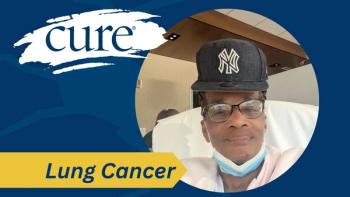
Tagrisso Gets Full Approval in Lung Cancer
Tagrisso (osimertinib) was granted a regular Food and Drug Administration (FDA) approval to treat some patients with lung cancer.
Tagrisso (osimertinib) was granted a regular Food and Drug Administration (FDA) approval as a treatment for patients with metastatic EGFR T790M mutation-positive non—small cell lung cancer (NSCLC) following prior treatment with an EGFR TKI, based on progression-free survival (PFS) findings from the phase 3 AURA3 trial.
In the randomized trial, Tagrisso demonstrated a median PFS of 10.1 months compared with 4.4 months for standard platinum-based chemotherapy. The median PFS for patients with central nervous system (CNS) metastases was 8.5 months with Tagrisso b versus 4.2 months with chemotherapy. Tagrisso was originally granted an accelerated approval in November 2015, based on an overall response rates (ORR) of 59 percent across two single-arm studies.
“These results show that osimertinib demonstrated a superior, clinically meaningful efficacy over platinum—pemetrexed, establishing the new standard of care for these patients,” said lead investigator Vassiliki A. Papadimitrakopoulou, M.D., form the MD Anderson Cancer Center, when she presented the findings at the IASLC 17th World Conference on Lung Cancer. “Patients receiving osimertinib experienced a 70 percent reduction in the risk of disease progression without severe toxicity, and similar efficacy was seen in patients with CNS metastases at baseline.”
In the open-label study, 419 patients were randomized in a 2-1 ratio to receive Tagrisso (279 patients) or a platinum-based chemotherapy doublet (140 patients). Tagrisso was administered once per day orally at 80 mg in a 21-day cycle. The chemotherapy arm included pemetrexed plus carboplatin or pemetrexed plus cisplatin. Pemetrexed was administered at 500 mg/m2, carboplatin was given at a dose of 5 AUC, and cisplatin was administered at 75 mg/m2.
The median age of patients in the Tagrisso arm was 62 years compared with 63 years in the chemotherapy cohort. Nearly all the patients had metastatic disease, and 33 percent and 36 percent of those in the Tagrisso and chemotherapy arms, respectively, had CNS metastases. Approximately 60 percent of the participants had received Iressa (gefitinib), 35 percent had been treated with Tarceva (erlotinib) and nearly 6 percent had taken Gilotrif (afatinib).
The ORR with Tagrisso was 71 percent versus 31 percent with chemotherapy. The six-month PFS rate was 69 percent with Tagrisso versus 37 percent with chemotherapy. At 12 months, 44 percent of those in the Tagrisso arm were progression-free versus 10 percent in the chemotherapy group. Data for overall survival were not yet available.
The most common adverse events of any grade, reported in more than 10 percent of participants, associated with Tagrisso included diarrhea (41 percent), rash (34 percent), dry skin (23 percent), and paronychia (22 percent). For those treated with platinum—pemetrexed, the most common toxicities of any grade were nausea (49 percent), decreased appetite (36 percent), constipation (35 percent) and fatigue (28 percent).
Grade 3 or higher AEs were reported in 23 percent of the Tagrisso group versus 47 percent of the chemotherapy arm. The most frequently reported grade 3 or higher events in the chemotherapy arm were neutropenia (12 percent), anemia (12 percent) and thrombocytopenia (7 percent). The incidence of each of those toxicities in the Tagrisso arm was 1 percent or less.
Findings from AURA3 were also published in The New England Journal of Medicine. At the time, the lead author, Tony Mok, M.D., noted that “With the publication of the AURA3 data, clinicians should perform T790M mutation testing to ensure Tagrisso be given to patients who are most likely to benefit.”
Several clinical trials continue to assess Tagrisso, both as a single agent and in novel combinations. A phase III study is exploring Tagrisso in the frontline setting following tumor resection, with or without adjuvant chemotherapy (




